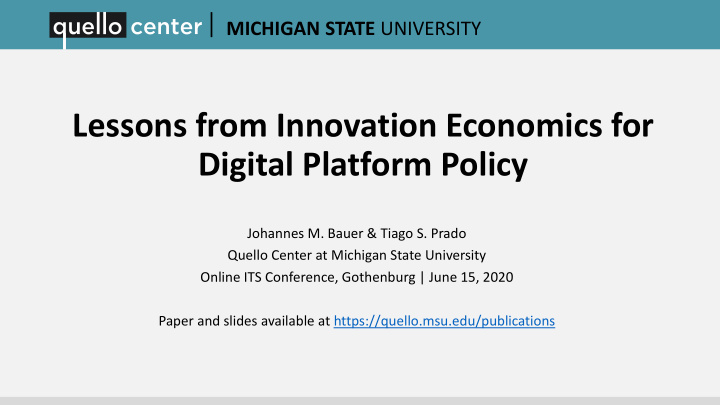



MICHIGAN STATE UNIVERSITY Lessons from Innovation Economics for Digital Platform Policy Johannes M. Bauer & Tiago S. Prado Quello Center at Michigan State University Online ITS Conference, Gothenburg | June 15, 2020 Paper and slides available at https://quello.msu.edu/publications
Background and motivation Source: Knight Foundation & Gallup, 2020 • Increasing concerns about platform power (e.g., abuse of dominance, negative effects on rate and direction of innovation, platform censorship) • Many policy proposals, significant disagreement as to what should be done • Incidents of violation of fair competition, little evidence on innovation impacts
Plan of presentation • Economics of complementary innovation • Empirical analysis of platform roles in venture capital funding • Preliminary policy implications
Economics of complementary innovation
Innovation as evolutionary search • Traditional approach to innovation distinguishes product, process, service, design, business model innovations (e.g., OECD, 2010) • Newer approaches emphasize “creation of novelty that contributes to sustainable increases in efficiency” (Antonelli, 2011) and wellbeing • Digital markets allow continuous process of experimentation, real-time feedback on outcomes, selection of successful models, and their replication and scaling (e.g., Brynjolfsson, 2011) • Essentially an evolutionary search process for new combinations and re-combinations of knowledge, an expansion into the “adjacent possible” (Kauffman, 1993)
Management of innovation ecosystems • Platforms are institutional solutions that unlock new forms of value co-creation (e.g., allow internalization of some externalities) • Need to overcome several management challenges (Williamson & De Meyer, 2020) • Pinpointing the added value • Structuring differentiated partner roles • Stimulating complementary partner investments • Reducing transaction costs • Enabling flexibility and co-learning • Engineering value capture mechanisms • Non-myopic “ecosystem leaders” seek to grow the revenues and profits of the entire network of partners and complementors
Complementary innovation Contestability B Opportunities B Appropriability B + +/– Applications, + services Innovation decisions players B (complementors) + – Rate and direction of innovation Coordination cost Complementarity • Private interest innovation • Public interest innovation + – Innovation decisions players A (platform) Platforms + +/– + Contestability A Opportunities A Appropriability A
Ambiguous effects of platforms Innovation drivers Positive effects Negative effects Coordination costs Reduction of coordination costs of Increased coordination costs for non- complementary innovators affiliated players Complementarity Enhance potential synergies (e.g., by Weaken potential synergies (e.g., by platform design choices and available imposing highly selective selection developer services) criteria for affiliation) Contestability Design platform ecosystem to optimize Adopt overly restrictive or overly degree of contestability permissive conditions for affiliation Opportunities Broaden innovation opportunities for Overly restrictive conditions for complementors with transparency (e.g., participation, control over partner funding, access to users) innovation decisions Appropriability, financial Sharing of service revenues designed to Revenue sharing biased in favor of sustainability improve appropriability conditions for platform revenues and profitability, pre- complementors, support for start-ups emptive policies toward start-ups (“kill and provision of venture capital zones”)
Empirical analysis of platform roles in venture capital activity
Platforms and start-up funding • The research literature provides evidence of a positive, causal association between venture capital activity and innovation • Platforms have many ways to affect innovation (e.g., by influencing the ability of start-ups to appropriate innovation rewards, providing start- up capital, biasing innovation in certain directions) • Empirical research questions for this paper • Do venture capital investments of digital platforms drive other venture capitalists to invest in startups in the same niches? • Does the presence of a platform in a deal attract additional venture capitalists to that deal? • Does the presence of a platform in a deal attract more funding to that deal?
Platforms and start-up funding …
Platforms and start-up funding …
Analysis of quarterly venture capital deals per sector
Analysis of quarterly venture capital deals per sector …
Analysis of funding and investors per deal
Analysis of funding and investors per deal …
Limitations and next steps • The data shows a strong asymmetric interdependence and parallel development of venture investments by digital platforms and other venture capitalists. • Insufficient to tell conclusively whether platforms boost or quench innovation (more data is needed for an industry-level analysis). • Next steps and future research • Examining additional factors that influence the decision-making process followed by venture capitalists before a deal; • Investigating in more detail whether “kill zones” are created by digital platforms investment and acquisitions for smaller projects; and • Assessing in more detail the net economic impact of positive and negative influences of digital platforms on innovation and the role of platform policy.
Preliminary policy implications
Lessons for platform policy 1. Non-myopic platforms have strong incentives to realize positive effects of complementary innovation 2. Given the many non-linear interdependencies, high uncertainty, and incomplete information, safeguards are desirable 3. Theory and empirical evidence caution against regulatory interventions such as breakups and structural separation 4. Functional and non-discrimination safeguards are better suited to protect the vibrancy of the overall innovation system 5. Where possible, institutional and organizational diversity and competition should be promoted 6. A framework of ex post regulation seems best able to achieve these goals
Resources • Bauer, J. M. and Prado, T. S. (2020). Lessons from innovation economics for digital platform policy. Quello Center Working Paper, available online at https://quello.msu.edu/publications.
Recommend
More recommend